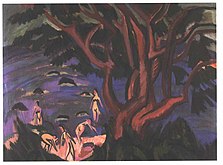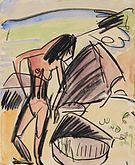Ernst Ludwig Kirchner on Fehmarn
From 1908 to 1914 Ernst Ludwig Kirchner spent four summer stays on Fehmarn , which totaled a period of at least nine months. They represent an important biographical phase in Ernst Ludwig Kirchner's life, which is characterized by a fascination with untouched nature and the simple and sensual life. Historically, Kirchner was, like many artists of his time, influenced by the life reform movement and nudism . Nudity in the great outdoors was a new sensual experience and at the same time stood for the liberation from traditional conventions , prudery and double standards .
The retreat Fehmarn , which Kirchner experienced as his paradise, triggered a creative frenzy. More than 120 oil paintings , hundreds of drawings, watercolors and sketches as well as numerous sculptures were created on Fehmarn, and only to a lesser extent in post-processing in the Berlin studio . With the motifs of the beach and the sea , the nudes in the open air, motifs of the island and its people, they form an independent group of works, which contrast with the motifs of the big city from the same period and with regard to the simple life in nature in the pictures continue the Davos time . According to Kirchner himself in a letter, the dominant colors are ocher, blue and green.
“Oh, Staberhuk, how wonderful you are, happiness in the corner peacefully beautiful!” A verse called out by Kirchner with open arms on the beach, transmitted by Niko Lüthmann, one of the children of the three-time hosts of the Kirchners on Fehmarn.
First stay in 1908
In 1908 Kirchner traveled to Fehmarn for the first time with his siblings Emmi (1884–1975) and Hans Frisch (1885–1945), with whom he had been friends since his youth. The way to the little developed island led from Dresden to Lübeck by train, from there by ship to the port of Burgstaaken in the southeast of the island. On the island itself, carriages and horse-drawn carts were the means of transport as well as a railway line with five stations. The three rented the gable room above the entrance halfway to the town of Burg in the "Villa Port Arthur", which is surrounded by meadows and a large orchard. From there, the castle, the port of Burgstaaken and the coast were within walking distance.
Emmi acted as his model and the picture Woman in a White Dress was created , which was auctioned in London in 2006 for 7.2 million euros. In sketchbook no. 4 there are farmhouses, port representations, beach and cloud pictures. Six further paintings, 30 pen and ink drawings and 17 prints can be assigned to this stay (p. 16).
Second stay in 1912
Before his second stay in Fehmarn from mid-July to mid-August 1912, Kirchner moved to Berlin after the “Brücke” was closed and met Erna Schilling, who accompanied him on this trip for the first time. Ten kilometers from Burg they took up quarters in Staberhuk at the south-eastern end of the island with the family of the lighthouse keeper Lüthmann, for whose eight children the Kirchners' stays were a welcome change. The family made the east gable room with two offsides available for the guests, which Kirchner called the "tower room". The Lüthmann daughters Dora and Frieda, born in 1901 and 1902, were allowed to act as models for Kirchner.
Kirchner made sketches and drawings of Burg and the nearby towns of Staberdorf , Meeschendorf and Vitzdorf and worked on the nearby coast. There he also carved his sculptures. During this stay, Erich Heckel and his girlfriend Sidi Riha came to visit and stayed with the Kirchners. Later, Max Pechstein joined the group, who stayed in the "Haus Seeblick" in Lemkenhafen .
Kirchner himself was very satisfied with the artistic result of this stay. "I painted pictures there of absolute maturity," he wrote to Gustav Schiefler . The result was the picture Stepping into the Sea and another 34 oil paintings, bathing scenes, views of the lighthouse, the coast, the surroundings and the town of Burg. Sketchbook No. 27 shows the island beach, horses and cows in the pasture, riders, avenues, the lighthouse and women with large hats. Schiefler describes the stylistic characteristic of the “Gotization” in the pictures of this phase, with arching and towering picture edges and breaking, splintering contours (p. 31 ff).
Third stay in 1913
During their next stay, probably from May to the end of September 1913, Ernst Ludwig Kirchner and Erna Schilling again sought out the Lüthmanns' quarters, with whom a friendly relationship had developed in mutual respect. This time they were accompanied by Kirchner's painting students Hans Gewecke and Werner Gothein. The painter Otto Mueller and his wife Maschka later came to visit . In contrast to urban life, Kirchner experienced Fehmarn as a paradise in harmony between man and nature, in the sensual and harmonious togetherness of friends and in harmony with hosts and their rural life. On Fehmarn his love for the simple life deepened, which was to continue after the crisis of the war years in Davos .
The year before, the schooner "Marie" was stranded off Fehmarn, to which Kirchner often swam out. There he got oak planks from which he made numerous sculptures and also built a hut on the beach in the eastern bay of Staberhuk, which also appears in drawings and watercolors. Historically, the interest of the time in the life of the so-called " primitives " and distant cultures played a role here, which Kirchner was influenced by, although he himself had never visited countries farther away, but his knowledge only from today's controversial Völkerschauen and the Related works by other artists. (P. 50 f) The joy of life experienced during this long summer is shown by the 68 paintings that were created over the three months. In his sculptures, Kirchner combined what was found with the intended design and in turn cites the sculptures created in the drawings and pictures. (P. 54 ff)
Last stay in 1914
The Kirchners' last summer stay on Fehmarn took place in 1914. They lived with the Lüthmanns again and enjoyed the summer joys of the island. Thirteen oil paintings were created, the last being the Moonlight on Fehmarn, which was only completed in Berlin . He also built a canoe from a self-felled and hollowed poplar tree , which can also be seen in drawings, while in reality it turned out to be unsuitable for water. (P. 59 ff)
The stay was ended on August 1st with news of the outbreak of war , which prompted the Kirchners to hastily break off their summer happiness and return to Berlin. On the return trip, they were arrested twice on suspicion of espionage , which, despite the fact that the misunderstanding was soon cleared up, became a first traumatic experience for Kirchner.
The summer months on Fehmarn are considered in Kirchner's literature as a time of happiness and harmony between man and nature, to which he could never return, either in real or inwardly.
Works created on Fehmarn (selection)
Ernst Ludwig Kirchner Association Fehmarn
In 1992 the Ernst Ludwig Kirchner Verein Fehmarn e. V. founded. The aim of the association is to track down, document and convey Kirchner's stays on the island. The resulting documentation can be seen as a permanent exhibition in the city library in Burg. In addition to reports from contemporary witnesses and information on Kirchner's life, it includes the works that were created on Fehmarn or were inspired by the stays as reproductions in original size as well as photographs of some sculptures. The association organizes film screenings, exhibitions, hiking and cycling tours on the painting motifs and has created a hiking map of Kirchner's work. The exhibition objects of the Kirchner reproductions were renovated and renewed in 2015 and additional prints were added.
The association also invites well-known and young artists to find inspiration for their own works on the island. Under the title “In Kirchner's footsteps”, the works will be exhibited as part of the “Burger Art Days”. B. the resulting works by Christopher Lehmpfuhl (2007), Fritz Vahle (2008), Friedel Anderson (2012), Doris Runge (poetry) (2015), Frauke Gloyer (2014) and paintings, drawings and graphics by the actor Armin Mueller-Stahl (2016). In 1999 the association was itself a winner of the Ostholstein Culture Prize. There is a collaboration with the Schleswig-Holstein State Museums Foundation as well as with the Kirchner Museum Davos , the Brücke Museum Berlin and the Chemnitz Art Collection .
literature
- Ernst Ludwig Kirchner Association Fehmarn e. V. (Ed.): Fehmarn - Kirchner's Paradise. Catalog for the exhibition from July 10 to August 20, 2017. Solivagus, Kiel 2017, ISBN 978-3-9817079-8-4 .
Individual evidence
- ↑ a b c d e f Steffen Krautzig: Ernst Ludwig Kirchner on Fehmarn. Morio Verlag, Heidelberg 2016.
- ↑ Kirchner Verein Fehmarn: Laburnum without Erna ( Memento from October 11, 2016 in the Internet Archive )
- ^ EL Kirchner Association Fehmarn
- ↑ Anke Wolff: Fehmarn - where artists find paradises (III). With Ernst Ludwig Kirchner in Fehmarn's heavenly solitude. In: (Journal) Schleswig-Holstein , 10/2002, pp. 1–3.
- ↑ Kirchner Verein Fehmarn: Friendship with the lighthouse keeper Lüthmann ( Memento from October 11, 2016 in the Internet Archive )
- ↑ Hans Delfs (ed.): EL Kirchner. The entire correspondence. Bern 2010.
- ↑ Kirchner Verein Fehmarn: Sculptures are made from beach debris. ( Memento from October 11, 2016 in the Internet Archive )
















